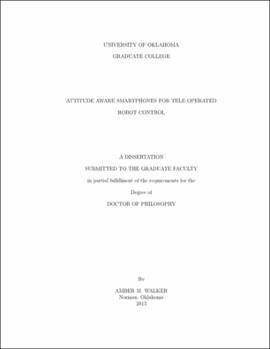| dc.contributor.advisor | Miller, David P | |
| dc.creator | Walker, Amber Michelle | |
| dc.date.accessioned | 2019-04-27T21:40:11Z | |
| dc.date.available | 2019-04-27T21:40:11Z | |
| dc.date.issued | 2013 | |
| dc.identifier | 9972729102042 | |
| dc.identifier.uri | https://hdl.handle.net/11244/319315 | |
| dc.description.abstract | The U.S. military has increasingly turned to unmanned ground vehicles (UGVs) to assist in the most dull, dirty, and dangerous missions. Their presence on the battlefield is redefining how war is waged, expanding opportunities for reconnaissance and surveillance while minimizing soldier mortality. Robotic systems have gotten ever smaller, many now being man-packable. Soldiers may now carry, deploy, and control their own robotic assistant, many with limited formal training. Unfortunately, UGVs add significantly to a soldier's standard load of water, ammunition, armor, and supplies, making weight and portability top concerns. One way to ease the soldier burden is to adopt smartphones for use as robot operator control units (OCUs). Their small, lightweight frame combined with processing power and adaptable software backbone may enable intuitive controls on a device well-suited for other military missions. | |
| dc.description.abstract | Field operations are often conducted when users are gloved and/or dirty, making common smartphone touch interfaces problematic. By using proprioceptive device inputs related to attitude, smartphones can be used for control in ways that minimize that touch interface. To test this, an attitude aware smartphone controller (using the device's accelerometers and gyroscope) for a small, tele-operated, ground robot was developed and assessed via a multi-phase usability experiment. The controller's motion algorithm made use of quaternion mathematics to simplify motion handling and the user interface. | |
| dc.description.abstract | Twenty-five users were recruited to assess usability of attitude aware controls, testing their suitability for driving and camera manipulation tasks. Participants operated a small tracked robot on an indoor course with controllers using either virtual joystick or tilt-based controls while metrics regarding performance, mental workload, and user satisfaction were collected. They were also exposed to customizable controls, identifying modes and settings which contributed most heavily to the controller's usability. Results indicate that attitude-based controls are suitable for tele-operated reconnaissance and surveillance, as 64% of users preferred tilt-based driving controls while performing equally as well as the alternative. Customized configurations showed 60% of users preferred tilt for driving tasks when throttle sensitivity and controller responsiveness could be manipulated. The inherent usability of attitude aware controls optimistically exhibit how smartphones can be leveraged for robotic control, even in harsh environments by gloved users. | |
| dc.format.extent | 236 pages | |
| dc.format.medium | application.pdf | |
| dc.language | en_US | |
| dc.relation.requires | Adobe Acrobat Reader | |
| dc.subject | Vehicles, Remotely piloted | |
| dc.subject | Mobile robots | |
| dc.subject | Tanks (Military science) | |
| dc.subject | Unmanned ground vehicles | |
| dc.subject | Smartphones | |
| dc.title | ATTITUDE AWARE SMARTPHONES FOR TELE-OPERATED ROBOT CONTROL | |
| dc.type | text | |
| dc.type | document | |
| dc.thesis.degree | Ph.D. | |
| ou.group | College of Engineering::School of Aerospace and Mechanical Engineering | |
